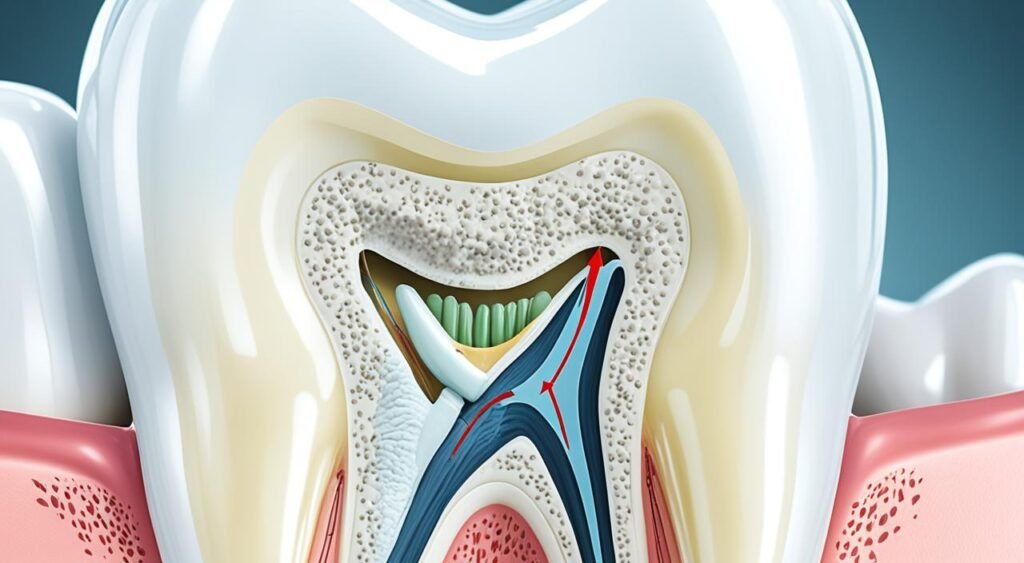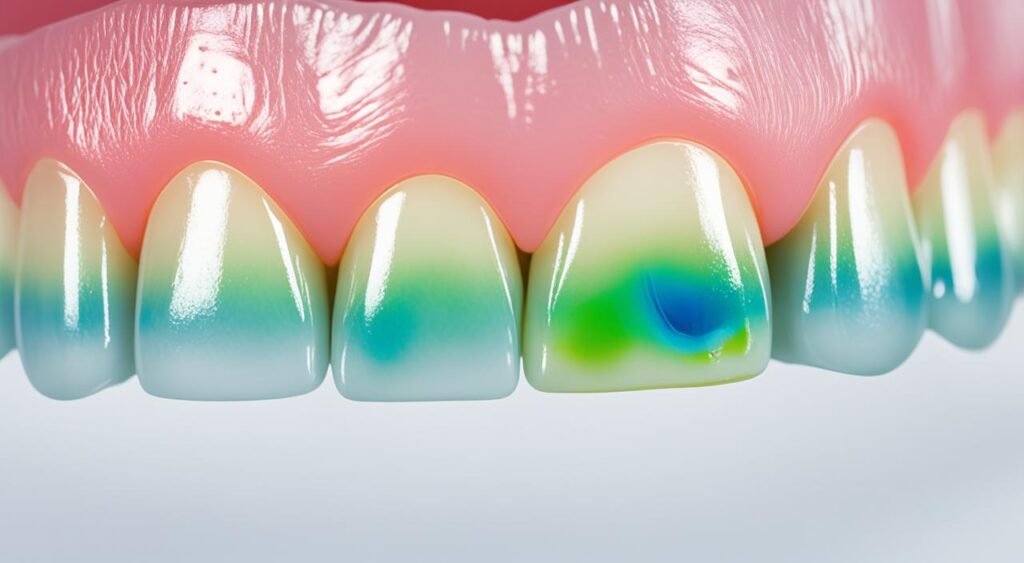Have you ever experienced a sharp zing in your mouth after biting into something cold or sipping a hot drink? If you’ve recently had dental fillings, this sensation isn’t uncommon. You’re not alone in your battle with sensitive teeth after dental work.
While dental care aims to improve the health and longevity of your teeth, the sensitivity can be a challenging aftereffect. Don’t worry; this article will dive into why you might feel discomfort and provide tips for alleviating tooth pain post-filling. Understanding the root of the sensitivity is the first step to getting back to enjoying your favorite foods without the wince.
Understanding Tooth Sensitivity: Why Does It Happen?
If you’ve ever winced from a spoonful of ice cream or a sip of hot coffee, you know the discomfort of tooth sensitivity. It’s a common issue that many encounter, but to understand its origins, a dive into the anatomy of a tooth and the conditions that impact it is essential. The structure of your teeth plays a critical role when it comes to sensitivity, especially when dental work comes into play.
Basics of Tooth Structure and Nerve Response
The human tooth is comprised of several layers, each with a specific function. The outermost layer, the enamel, is the hard, protective surface that faces the daily challenges of biting and chewing. Beneath the enamel lies the dentin, a less dense layer that contains microscopic channels leading to the dental pulp. The dental pulp is the innermost layer where blood vessels and nerves reside, which is why tooth nerve pain can be acute when this area is disturbed.
During dental procedures, even something as routine as placing a filling, these layers can be affected. This is where the concept of tooth sensitivity really comes into light, as the nerves within the dental pulp react to changes in temperature or pressure, sending pain signals to the brain. It’s a defense mechanism that can turn problematic if persistent.
Common Triggers for Sensitive Teeth
Sensitivity can be set off by various stimuli, but there are several common triggers of tooth sensitivity that you should be aware of. These include:
- Temperature extremes from foods or drinks
- Sweet or acidic foods that can erode enamel
- Aggressive brushing that wears down enamel and dentin
Just imagining a cold drink on a sensitive tooth can send chills down your spine. It’s key to recognize these triggers as they hint at underlying issues like enamel erosion or dentin exposure, which increase the likelihood of experiencing discomfort.
In essence, understanding the delicate interplay between your tooth’s anatomy and the elements that can trigger sensitivity is the first step towards managing and preventing tooth nerve pain and discomfort. So, next time you feel that twinge, remember it’s your teeth telling you that they need attention.
Tooth Sensitivity After Filling: An Overview
Understanding postoperative tooth sensitivity is crucial if you’ve recently had a dental restoration. It’s not uncommon to experience some sensitivity following dental procedures. This discomfort is often due to the temporary irritation of the tooth’s nerves during the placement of a filling. However, you can take solace in the fact that this type of sensitivity typically diminishes as your tooth adjusts to the new restoration.
One contributing factor to dental restoration sensitivity is the manipulation of the tooth’s structure. Whether you have received a direct or indirect filling, the process involves cleaning the cavity and filling it with a material that will restore the tooth’s shape and function. During this procedure, the dental materials used, as well as the tools for placing the restoration, might temporarily distress the nerves within your tooth, leading to increased sensitivity to temperature, pressure, or sweetness.
As you navigate aftercare for tooth fillings, keep in mind that mild and fleeting sensitivity is quite normal. However, if you find yourself continuing to suffer from sharp pains or prolonged discomfort after your dental work, it’s imperative to reach out to your dentist. Severe sensitivity could indicate the need for an adjustment to the filling or an alternate form of treatment to properly remedy the issue.

When dealing with this form of sensitivity, there are practices and remedies to help mitigate the discomfort. Below, you’ll find a list of recommendations to assist in the aftercare of your dental restoration, offering both short-term relief and long-term benefits to your dental health:
- Use a soft-bristled toothbrush and gentle brushing techniques to avoid aggravating sensitive areas.
- Consider a toothpaste designed for sensitive teeth; they often contain compounds that can help reduce nerve sensitivity over time.
- Avoid extremely hot or cold foods and beverages that might trigger sensitivity.
- If discomfort persists beyond a reasonable time frame, consult your dentist to rule out issues like a high filling or a possible infection.
Managing postoperative tooth sensitivity effectively requires an understanding of both the causes and the potential solutions. Proper dental hygiene and mindful aftercare can make a significant difference in your comfort following a tooth filling. Remember, open communication with your dental professional is key to ensuring a smooth and successful recovery from any dental restoration procedure.
Common Causes Behind Your Tooth Sensitivity Post-Filling
Experiencing tooth sensitivity after a filling is not uncommon, and there are several key factors that could be the cause. Understanding why sensitivity occurs could help you address it effectively and prevent future discomfort.
Type of Filling Material Used
When it comes to dental filling materials, both amalgam and composite resin are popular choices among dental professionals. However, each material has different properties that can influence your teeth’s response. Amalgam sensitivity is a concern for some patients due to its metal content, causing a thermally conductive reaction to hot or cold stimuli. On the other hand, composite resin fillings are less likely to cause sensitivity as they bond directly to the tooth, offering a more insulative protection.
Technique and Quality of the Filling Procedure
The finesse with which your dentist performs the procedure is crucial. Proper dental techniques are essential to prevent excessive irritation to the tooth’s nerve during the procedure. A skilled dentist will ensure that the filling is placed delicately and polished to avoid any unnecessary sensitivity post-treatment.
Depth and Size of the Dental Cavity
The depth and size of the dental cavity being filled can significantly impact post-filling sensitivity. Cavities closer to the tooth’s nerve are more likely to result in discomfort after the procedure, especially if the filling material comes into direct contact with the nerve. Precision in the excavation and filling of the cavity is paramount to minimize this sensitivity.
Being familiar with these factors can help you discuss options with your dentist and select the most appropriate treatment for your needs. Ultimately, this knowledge equates to a more comfortable experience during and after your dental visit.
Immediate Relief for Sensitive Teeth After Dental Work
Experiencing tooth sensitivity after dental procedures can be quite a discomfort. This sensitivity may manifest as a sharp pain when your teeth come into contact with hot, cold, sweet, or acidic foods and beverages. However, there are reliable options for tooth sensitivity treatment that can provide pain relief and contribute to dental pain management right at home. Let’s uncover how over-the-counter solutions can cushion the discomfort and home remedies that might offer solace to your pearly whites in distress.
Over-the-Counter Solutions
Fortunately, the market offers a range of products specifically formulated to address tooth sensitivity. Desensitizing toothpaste, for instance, contains active ingredients like potassium nitrate or stannous fluoride that help block the transmission of pain signals from the surface of your tooth to the nerve. Regular use of these toothpastes can gradually diminish sensitivity. Additionally, pain-relieving gels with benzocaine can be applied directly to the affected tooth to provide temporary relief. It’s important to follow the instructions on these products diligently to maximize their effectiveness.
Home Remedies to Alleviate Pain
Apart from pharmacy solutions, simple home remedies are a supplementary course for mitigating tooth sensitivity. A saltwater rinse, which involves dissolving a teaspoon of salt in warm water and swishing it around in the mouth, can soothe inflammation and act as a natural antiseptic. Additionally, a warm compress applied to the cheek can help reduce discomfort. While these measures can provide immediate relief, they are not permanent solutions. If your tooth sensitivity persists or worsens, it is crucial to consult your dentist to explore long-term treatment options and ensure there’s no underlying issue needing professional care.
FAQ
Why does tooth sensitivity occur after getting a dental filling?
Tooth sensitivity after a filling is fairly common and can be attributed to the reaction of your tooth’s nerves to the disturbance caused by the procedure. The sensitivity is usually temporary and should subside as your tooth adapts to the new filling.
What are some common triggers for tooth sensitivity?
Tooth sensitivity can be triggered by a variety of factors, including exposure to hot and cold temperatures, sweet or acidic foods, and even aggressive tooth brushing. These triggers can cause discomfort due to the exposure of dentin or a response from the tooth’s nerve.
What is the role of enamel in tooth sensitivity?
Enamel is the hard, outermost layer of your teeth that protects the sensitive dentin underneath. When enamel is worn down or damaged, it can lead to the exposure of dentin, making your teeth more susceptible to sensitivity.
How can the type of filling material used affect sensitivity?
Different filling materials, like amalgam or composite resin, have unique properties that can influence tooth sensitivity. For instance, metals in amalgam fillings can conduct temperature more readily, potentially leading to sensitivity, while composite resins usually provide better insulation against such changes.
Can the depth and size of a dental cavity increase sensitivity post-filling?
Yes, the closer the cavity is to the tooth’s nerve, the higher the chances of sensitivity after the filling. Larger and deeper cavities can require more extensive drilling, which can agitate the nerve and cause postoperative sensitivity.
What are some over-the-counter solutions to alleviate tooth sensitivity after a filling?
Over-the-counter solutions include desensitizing toothpaste, which contains compounds that help block transmission of sensation from the tooth surface to the nerve, and pain-relieving gels that can be applied directly to the sensitive area for temporary relief.
Are there any home remedies to help with sensitive teeth after dental work?
Yes, home remedies like rinsing with warm salt water can help reduce inflammation, and applying a warm compress to the cheek can alleviate discomfort. These measures are intended for temporary relief and it’s recommended to consult your dentist if sensitivity persists.
When should I see a dentist about my sensitive teeth after a filling?
While mild sensitivity after a filling is normal for a few days, if you experience ongoing or severe discomfort, or if the sensitivity does not improve, you should visit your dentist to ensure there aren’t any underlying issues needing attention.









2 Comments
Pingback: Disadvantages of Dental Crowns: What to Know
Pingback: Kill Tooth Pain Nerve in 3 Seconds Permanently